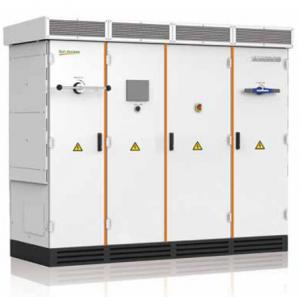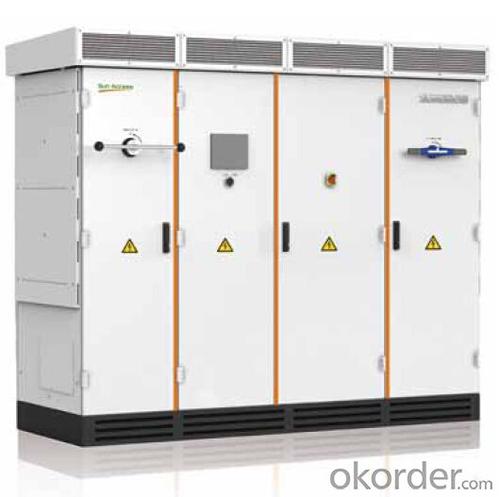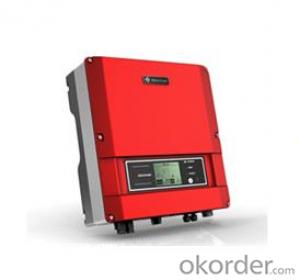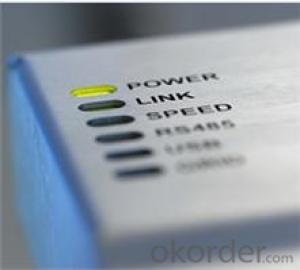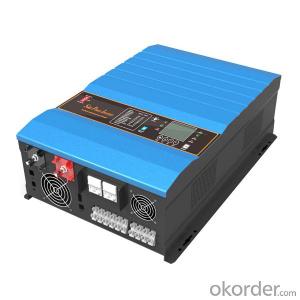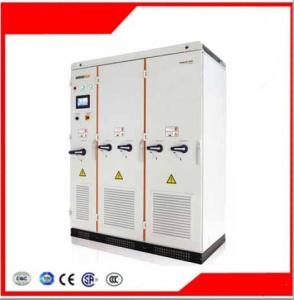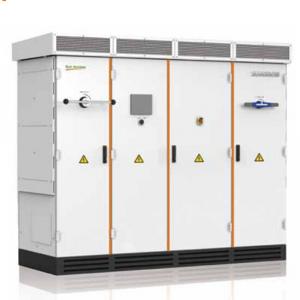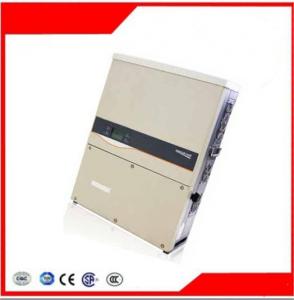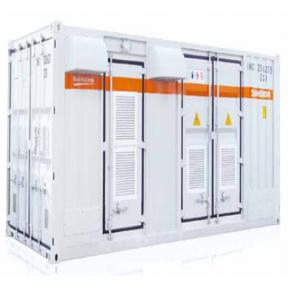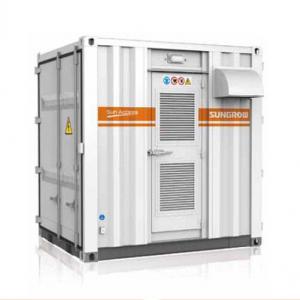PCS Solar Inverter - Photovoltaic Grid-Connected Inverter SG800MX
- Loading Port:
- China Main Port
- Payment Terms:
- TT or LC
- Min Order Qty:
- 50 unit
- Supply Capability:
- 1000 unit/month
OKorder Service Pledge
OKorder Financial Service
You Might Also Like
1. Structure of Photovoltaic Grid-Connected Inverter SG800MX Description
A solar inverter, or PV inverter, or Solar converter, converts the variable direct current (DC) output of a photovoltaic (PV) solar panel into
autility frequency alternating current (AC) that can be fed into a commercial electrical grid or used by a local, off-grid electrical network.
It is acritical BOS–component in a photovoltaic system, allowing the use of ordinary AC-powered equipment. Solar inverters have
special functions adapted for use with photovoltaic arrays, including maximum power point tracking and anti-islanding protection.
Suitable for 50Hz/60Hz grid, could be used in Asia, North America and Europe.
2. Main Features of the Photovoltaic Grid-Connected Inverter SG800MX
• Transformerless inverter, max. efficiency of 98.7%, CEC efficiency of 98.5% for SG800MX,max. efficiency of 98.6%, CEC efficiency of 98.0% for SG750MX
• Employing a patented thermal management system, the inverter is able to operate from -13˚F to 140˚F (-25˚C to 60˚C), and up to 19,600’ (6,000 m).
• High power density, small equipment footprint
• DC disconnect, AC circuit breaker, separate DC & AC cabinets
• Max. DC input voltage is 1000V, can be mounted on a skid or an e-house, giving maximum design flexibility and lowering installation costs
• Continuous active power control
• Advanced grid support functionality, meet grid requirements around the world
• Full remote and local power curtailment, PF, HVRT, LVRT, FRT controls via ModBus & Ethernet
• Designed for 20+ years of operating life
• NEMA4X electronics cabinet
3. Photovoltaic Grid-Connected Inverter SG800MX Images
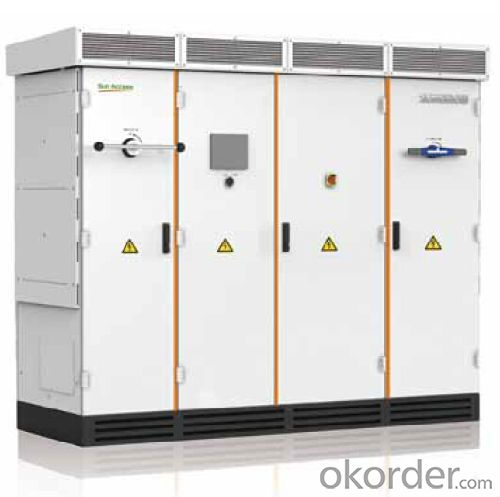
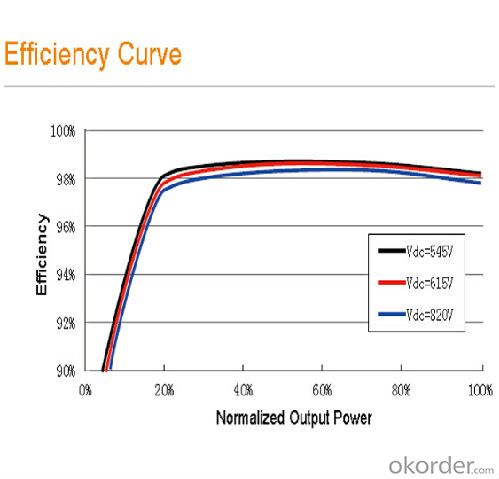
4. Photovoltaic Grid-Connected Inverter SG800MX Specification
Input Side Data |
|
Max. PV input power | 900kW |
Max. PV input voltage | 1000V |
Start voltage | 565V |
Min. operation voltage | 545V |
Max. PV input current | 1600A |
MPP voltage range | 545~820V |
No. of DC inputs | 1, 6-12 |
PV array configuration | Negative ground (standard), Floating or Positive Ground (optional) |
Output Side Data |
|
Nominal AC output power | 800kW |
Max. AC output apparent power | 880kVA |
Max. AC output current | 1512A |
THD | <3% (nominal power) |
Nominal AC voltage | 342V |
AC voltage range | 300~377Vac |
Nominal grid frequency | 50/60Hz |
Grid frequency range | 47~52Hz/57~63Hz |
Power factor | >0.99@default value at nominal power, adj. 0.8 overexcited~0.8 underexcited |
Isolated transformer | No |
DC current injection | <0.5 % In |
Efficiency |
|
Max. efficiency | 98.70% |
European efficiency | 98.40% |
CEC efficiency | 98.50% |
Protection |
|
Input side disconnection device | DC load switch |
Output side disconnection device | Breaker |
DC overvoltage protection | Yes |
AC overvoltage protection | Yes |
Grid monitoring | Yes |
Ground fault monitoring | Optional |
Over temperature protection | Yes |
Insulation monitoring | Optional |
General Data |
|
Dimensions(W×H×D) | 2598x2164x1000mm |
Weight | 2340kg |
Operating ambient temperature range | -25~+60℃(>55℃ derating) |
Noise emission | <70dB |
Night power consumption | <100W |
External auxiliary supply voltage | 480/600V(3/N/PE) |
Cooling method | Temperature controlled air-cooling |
Ingress protection rating | NEMA 3R(IP54) |
Allowable relative humidity range | 0~95% no condensing |
Max. operating altitude | 6000m (>3000m derating) |
Fresh air consumption | 4425 m³/h |
Display | LCD |
Communication | RS485/Modbus, Ethernet(Opt.) |
5. FAQ of Photovoltaic Grid-Connected Inverter SG800MX
Q1. What is the difference between inverter and solar inverter?
A1. Inverter only has AC inpput, but solar inverter both connect to AC input and solar panel, it saves more power.
Q2. What is the difference between MPPT&PWM?
A2. MPPT has higher efficiency, it can track the max power point and won't waste energy.
- Q: Can a solar inverter be connected to a battery storage system?
- Yes, a solar inverter can be connected to a battery storage system. This allows excess solar energy generated during the day to be stored in the batteries and used later when there is no sunlight, providing a reliable source of power.
- Q: How does a solar inverter handle power quality disturbances?
- A solar inverter handles power quality disturbances by continuously monitoring the electrical grid and adjusting its output accordingly. It employs various techniques such as voltage regulation, frequency control, and power factor correction to ensure that the power it feeds into the grid is of high quality and meets the required standards. Additionally, some advanced solar inverters also have built-in features like anti-islanding protection to prevent the injection of power into the grid during a disturbance, ensuring the safety of both the solar system and the grid.
- Q: How does a solar inverter impact the payback period of a solar system?
- A solar inverter plays a crucial role in converting the direct current (DC) electricity generated by solar panels into usable alternating current (AC) electricity for household or grid consumption. The efficiency and performance of the solar inverter directly impact the overall energy production of the solar system. A higher quality and more efficient solar inverter can maximize the electricity generation, reducing the payback period of the solar system. Conversely, a low-quality or inefficient solar inverter may result in lower energy output, potentially extending the payback period of the solar system.
- Q: What is the role of a surge protector in a solar inverter?
- The role of a surge protector in a solar inverter is to protect the sensitive electronic components of the inverter from power surges or voltage spikes that may occur in the electrical grid. By diverting excess voltage away from the inverter, it helps to prevent damage and ensure the reliable operation of the solar system.
- Q: What is the purpose of a solar inverter?
- The purpose of a solar inverter is to convert the direct current (DC) electricity generated by solar panels into alternating current (AC) electricity that can be used to power household appliances or be fed back into the electrical grid.
- Q: Can a solar inverter be integrated with a smart home system?
- Yes, a solar inverter can be integrated with a smart home system. This integration allows for monitoring and controlling the solar energy production, as well as optimizing energy usage and managing the overall efficiency of the system.
- Q: Can a solar inverter be used in a solar-powered air conditioning system?
- Yes, a solar inverter can be used in a solar-powered air conditioning system. A solar inverter is responsible for converting the direct current (DC) generated by solar panels into alternating current (AC) that is compatible with the electrical requirements of air conditioning systems. By using a solar inverter, the solar energy captured by the panels can be efficiently used to power the air conditioning system, making it a sustainable and eco-friendly solution.
- Q: What is the typical size and weight of a solar inverter?
- The typical size and weight of a solar inverter can vary depending on the capacity and type of the inverter. However, most residential solar inverters have dimensions ranging from around 12 x 8 x 5 inches and weigh between 20 to 40 pounds. Commercial or utility-scale inverters can be much larger and heavier, often weighing several hundred pounds and having larger dimensions.
- Q: Can a solar inverter be used in a solar-powered telecommunications system?
- Yes, a solar inverter can be used in a solar-powered telecommunications system. The solar inverter is responsible for converting the direct current (DC) produced by solar panels into alternating current (AC) that can be used to power various devices in the system, including telecommunications equipment.
- Q: Can a solar inverter be used in a solar water pumping system?
- Yes, a solar inverter can be used in a solar water pumping system. The solar inverter is responsible for converting the direct current (DC) power generated by the solar panels into alternating current (AC) power, which is suitable for powering the water pump. This allows the solar water pumping system to operate efficiently and effectively, utilizing the solar energy to pump water without the need for grid electricity.
Send your message to us
PCS Solar Inverter - Photovoltaic Grid-Connected Inverter SG800MX
- Loading Port:
- China Main Port
- Payment Terms:
- TT or LC
- Min Order Qty:
- 50 unit
- Supply Capability:
- 1000 unit/month
OKorder Service Pledge
OKorder Financial Service
Similar products
Hot products
Hot Searches
Related keywords
